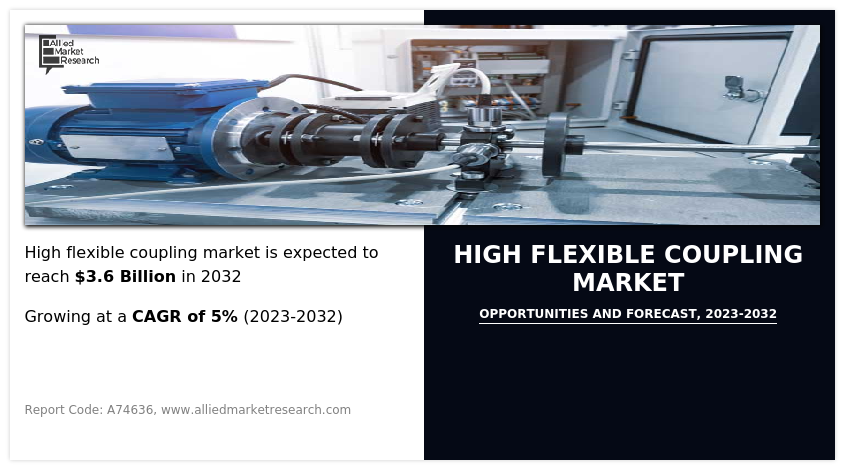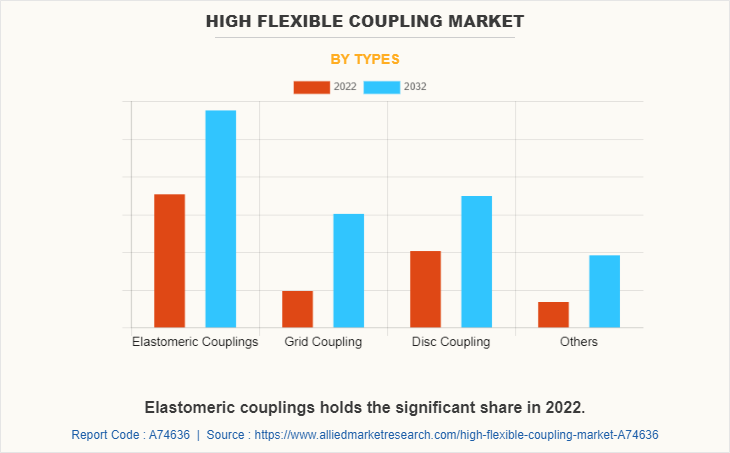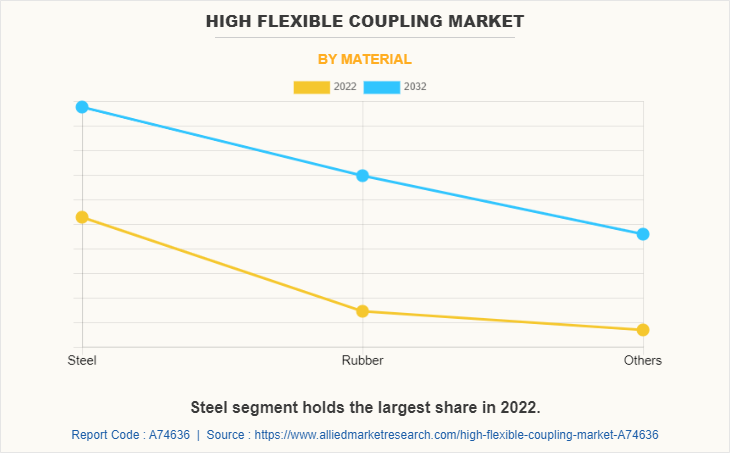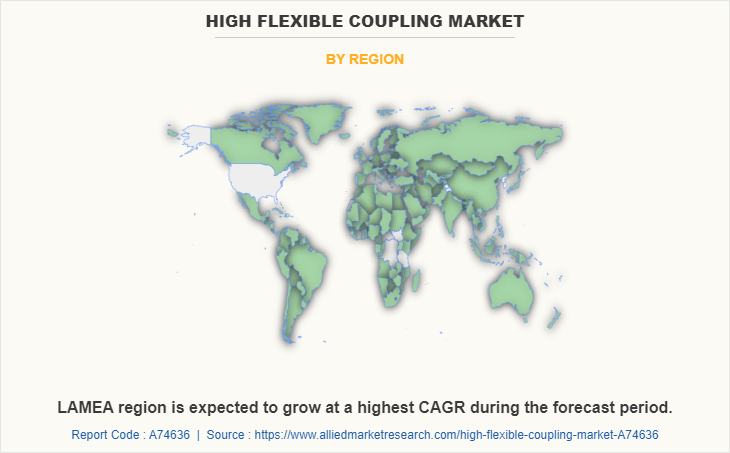High Flexible Coupling Market Research: 2032
The Global High Flexible Coupling Market was valued at $2.2 billion in 2022, and is projected to reach $3.6 billion by 2032, growing at a CAGR of 5% from 2023 to 2032. The high flexible couplings join two shafts end to end in a straight line so that they may rotate at the same speed. Axial movement for coupling due to the expansion of renewable energy installation, such as wind and shaft misalignment are also possible with these flexible shafts. Misalignment is utilized to soften vibrations and transfer torque from one shaft to another. It is frequently employed in fields such the oil and gas industry, mining, industrial applications, and others where gearboxes with severe torque are necessary.

Market Dynamics
Increased building and infrastructure development worldwide is fueling the need for high-flexible couplings. Moreover, these couplings are employed to facilitate torque transmission and misalignment adjustment in a variety of construction machinery, including excavators, cranes, and concrete pumps.
Furthermore, it is projected that an increase in building activity will raise demand for material-handling equipment such as excavators and pullers. In addition, an increase in construction activities is anticipated to boost the demand for material-handling devices such as excavators and pullers. Furthermore, major players that provide excavators in France include JCB, Volvo AB, and John Deere. For instance, in March 2020, J C Bamford Excavators Ltd launched its new 8025 ZTS mini excavator. It offers a 20.9 Kw Perkin engine with a weighing capacity of 2.8 tons. It also required high flexible coupling for better torque. It is most suitable for construction, and landscaping areas. market for high flexible coupling is projected to grow with ongoing infrastructure projects in emerging economic and urbanization trends,
However, the high flexible coupling industry is currently experiencing significant growth restrictions due to the rapid pace of innovation, the need for industrial providers to adapt to new technology infrastructures, and the need to enhance their operations and business processes. Moreover, lack of awareness for the advantages of automated processes and technical proficiency, alongside the continuous innovation in manufacturing processes, poses challenges to the highly flexible coupling market growth.

By Type:
The high flexible coupling market is divided into elastomeric coupling, grid coupling, disc coupling, and others (membrane couplings, and universal coupling). Elastomeric coupling, known as flexible, or rubber coupling are mechanical devices used to connect two rotating saft in machinery or equipment. In addition, grid couplings is a particular kind of power transmission tool that joins two rotating shafts. They help keep the shafts from going out of alignment and are utilized to transfer power between them. Moreover, grid couplings can be utilized to reduce noise and vibration.
Furthermore, A disc coupling is a mechanism that uses one or more discs to couple two revolving shafts. Typically composed of metal, the discs are attached to the shafts to allow for independent rotation. The others segment includes such as membrane couplings, and elastomeric coupling. A universal coupling connects stiff shafts whose axes are inclined towards one another. It is frequently utilized in rotary motion-transmitting shafts. It comprises two hinges joined by a cross shaft that are near to one another and are aligned at 90 degrees to one another.
Elastomeric coupling is expected to exhibit the largest revenue contributor during the forecast period. Grid coupling is expected to exhibit the highest CAGR share in the type of segment in the highly flexible coupling market during the forecast period that is further driving the high flexible coupling market growth.
Moreover, the demand for high flexible coupling is expected to grow with the increase in adoption of industrial automation and robotics. These coupling facilities smooth power transmission and compensate for misalignments in robotics arms, automated assembly lines and material handling systems. In addition, the emergence of industrial automation and smart robotic applications platforms is an important factor for the overall growth of automation components market in manufacturing, aerospace, and other industries.
Moreover, key market players are focused on the development of new products to strengthen their product portfolio. For instance, in June 2022, KTR Systems GmbH launched its new intermediate shaft coupling from the Rotex family. Aluminum is used for the shaft, which enables shaft distances of up to 4,000 mm. Five sizes of the ROTEX ZRS are offered for torques up to 560 Nm. Such advancements in automation components are expected to offer lucrative opportunities for the expansion of the high flexible coupling market size during the forecast period.

By Material type:
The High flexible coupling market is divided into rubber, steel, and others (ceramics, plastics, and composite materials). Rubber is like components such as elastomer that join two shafts and permit only a little amount of rotation. They are frequently utilized in applications where there is a lot of vibration or movement as they can absorb some of the shocks. Flexible couplings are another name for elastomer. In addition, mild steel couplings and stainless-steel couplings are just two of the many varieties of metal couplings that are offered.
There are various working pressures that each of these can withstand while still performing effectively. Furthermore, other coupling materials such as ceramic, plastic, and composite materials. Plastic push-in couplings and threaded plastic pipe connectors are only two examples of the many varieties of plastic couplings that are available. There are various working pressures that each of these can withstand while still performing effectively. The steel segment is expected to be the largest revenue contributor during the forecast period, and the rubber segment is expected to exhibit the highest CAGR share in the material segment in the high flexible coupling market during the forecast period.
Furthermore, several commodities, including food items, oil, and gas, saw a surge in price because of the Russia-Ukraine conflict. There are more expensive shipping costs, fewer available containers, and less warehouse space now due to supply chain interruptions. Certain ports have been closed, and orders are being retracted, since there have been delays in shipments and congestion, which has an effect on industry and consumers globally. Moreover, decline in investor confidence has increased stock market volatility. Economic instability has risen because of the strained commercial ties between Russia, Ukraine, and their different trading partners. All these factors have reduced export possibilities.
The high flexible couplings market is segmented into type, material, end user, and region. On the basis of type, it is segregated into elastomeric coupling, grid coupling, disc coupling, and others (membrane couplings, and universal coupling). On the basis of the material, it is classified into rubber, steel, and others (ceramics, plastics, and composite materials). Based on end-user industry, the market is divided into automotive, oil & space, power generation, and others (plastic, and transportation). On the basis of region, it is analyzed across North America (the U.S., Canada, and Mexico), Europe (UK, Germany, France, Spain, Italy, Netherlands, and Rest of Europe). Asia-Pacific (China, Japan, India, South Korea, and rest of Asia-Pacific), and LAMEA (Latin America, the Middle East, and Africa).

By End User:
The high flexible coupling market is divided into oil & gas, automotive, power generation and other (plastic, transportation). The current generation of automobiles are software-enabled, data-generating, network-connected machines, which opens the door to new (data) products and services. High flexible coupling assists automakers in remaining competitive by enhancing everything from research to design, production, and even‐¯marketing processes campaigns for their products. High flexible coupling is used in a variety of machinery such as spare parts, vehicles, manufacturing machinery, robotics, and others. In addition, A short piece of pipe is used to unite two casing joints. A casing coupling has internal threads that are machined to match the long joints of the casing's external threads. The two casing joints are threaded into the casing opposing ends of coupling. Furthermore, a coupling is employed whenever a connection is created between two revolving pieces of machinery, such as a generator and a turbine. Power transmission elements called couplings are used to join two shafts. Moreover, the other segments include mining, healthcare, energy, plastic, transportation, chemical & pharma, and manufacturing.
The oil and gas segment are expected to be the largest revenue contributor during the forecast period, and the power generation segment is expected to exhibit the highest CAGR share in the end-user segment in the high flexible coupling market during the forecast period.

By Region:
The high flexible coupling market is analysed across North America, Europe, Asia-Pacific, and LAMEA. In 2022, Europe held the highest revenue in high flexible coupling market share. LAMEA is expected to exhibit the highest CAGR during the forecast period. The demand for high flexible coupling is projected to expand in the European region because of Europe's increased focus on the production of renewable energy such as wind, solar, hydro and biomass. According to a report published on Renewable Energy in Europe in March 2020, by the European Commission, the European power production from renewable resources surpassed the power produced by coal in 2020. Furthermore, Finland, Sweden, Denmark, Austria, and Latvia were the five nations with the largest proportion of renewable energy generation.
In addition, the demand for highly flexible coupling in LAMEA is projected to increase as the industrial infrastructure there develops. Latin America has significant growth potential for sectors like pharmaceutical, food and beverage processing, manufacturing, and chemicals, mostly because the region has an abundance of the natural resources required for production. In addition, the demand for automation and iot in Latin America, the Middle East, and Africa is also growing significantly, owing to the developed lifestyles and increase in per capita income of population. This has helped the countries to increase their focus on the automation industry, which can create opportunities for the growth in demand for high flexible coupling in the region.
Competition Analysis
The major players profiled in the high flexible couplings market include.
VULKAN Group, Flender, The Timken Company, Renold PLC, KTR Systems GmbH, Stromag France, Comintec, Renk aktiengesellschaft, Ortlinghaus-Werke GmbH, Kawasaki Heavy Industries. Major companies in the market have adopted acquisition, product launch, and other strategies as their key developmental strategies to offer better products and services to customers in the High flexible couplings market.
Some examples of acquisition in the market:
In August 2022, Renold acquired the entire issued share capital of Industrias YUK S.A. for a total cash consideration of €24 million. The acquisition is expected to enable Renold to sell YUK products across the entirety of its wide European sales network, outside of Iberia, and to capitalize on strong CVC market position of YUK in Spain and Portugal to increase sales of the current line of group of premium European TRC products.
Some examples of product launched in the market:
In February 2023, VULKAN Group launched its VULASTIK XT product for use in industrial applications such pumps, fans, compressors, and blowers as well as the market for generator sets. Moroeover, it is appropriate for drives in mobile applications like trains, mobile equipment, and more that use diesel or petrol engines.
In July 2020, Renold Hi-Tec Couplings launched a new line of rubber, anti-vibration engine mountings and flexible couplings for marine applications. The new VF couplings are intended for use with high-speed, flex-mounted diesel engines with a torque range of 5,000 to 18,000Nm. They are intended for use on recreational craft, workboats, fishing boats, and tugboats.
In June 2022, KTR Systems GmbH launched its new intermediate shaft coupling from the Rotex family. Aluminum is used for the shaft, which enables shaft distances of up to 4,000 mm. Five sizes of the ROTEX ZRS are offered for torques up to 560 Nm.
Key Benefits For Stakeholders
- This report provides a quantitative analysis of the high flexible coupling market forecast, market segments, current trends, estimations, and dynamics of the high flexible coupling market analysis from 2022 to 2032 to identify the prevailing high flexible coupling market opportunities.
- The market research is offered along with information related to key drivers, restraints, and opportunities along with high flexible coupling market outlook.
- Porter's five forces analysis highlights the potency of buyers and suppliers to enable stakeholders make profit-oriented business decisions and strengthen their supplier-buyer network.
- In-depth analysis of the high flexible coupling market segmentation assists to determine the prevailing market opportunities.
- Major countries in each region are mapped according to their revenue contribution to the global market.
- Market player positioning facilitates benchmarking and provides a clear understanding of the present position of the market players.
- The report includes the analysis of the regional as well as global high flexible coupling market trends, key players, market segments, application areas, and market growth strategies.
High Flexible Coupling Market Report Highlights
| Aspects | Details |
| Market Size By 2032 | USD 3.6 billion |
| Growth Rate | CAGR of 5% |
| Forecast period | 2022 - 2032 |
| Report Pages | 236 |
| By Types |
|
| By Material |
|
| By End User Industry |
|
| By Region |
|
| Key Market Players | VULKAN Group, Renk aktiengesellschaft, KTR Systems GmbH, The Timken Company, Kawasaki Heavy Industries, Stromag France, Flender, Ortlinghaus-Werke GmbH, comintec, Renold PLC |
Analyst Review
The High flexible couplings market has witnessed significant growth in the past few years, by joining two shafts end to end in the same line, the flexible couplings enable them to revolve at the same speed. These flexible shafts enable axial movement and shaft misalignment. Misalignment is utilized to soften vibrations and transfer torque from one shaft to another. It is commonly utilized in sectors including the oil and gas industry, mining, industrial applications, and others where gearboxes with severe torque are necessary. Furthermore, rise in infrastructure development and construction project and rise in automotive industries provide lucrative growth in high flexible coupling.
However, fluctuating prices of raw materials are anticipated to limit the market growth. Contrarily, the integration of industrial automation and robotics in different manufacturing machinery provides lucrative opportunities for the growth of the market.
The global high flexible coupling market was valued at $2,238.7 million in 2022, and is projected to reach $3,629.0 million by 2032, registering a CAGR of 5.0% from 2023 to 2032.
The forecast period considered for the global high flexible coupling market is 2022 to 2032, wherein, 2022 is the base year, 2023 is the estimated year, and 2032 is the forecast year.
The latest version of global high flexible coupling market report can be obtained on demand from the website.
The base year considered in the global high flexible coupling market report is 2022.
The top companies holding the market share in the global high flexible coupling market report are VULKAN Group, Flender, The Timken Company, Renold PLC, KTR Systems GmbH, Stromag France, Comintec, Renk aktiengesellschaft, Ortlinghaus-Werke GmbH, Kawasaki Heavy Industries.
The top ten market players are selected based on two key attributes - competitive strength and market positioning.
The report contains an exclusive company profile section, where leading companies in the market are profiled. These profiles typically cover company overview, geographical presence, market dominance (in terms of revenue and volume sales), various strategies and recent developments.
By type, the elastomeric coupling segment is the highest share holder of high flexible coupling market.
Loading Table Of Content...
Loading Research Methodology...


